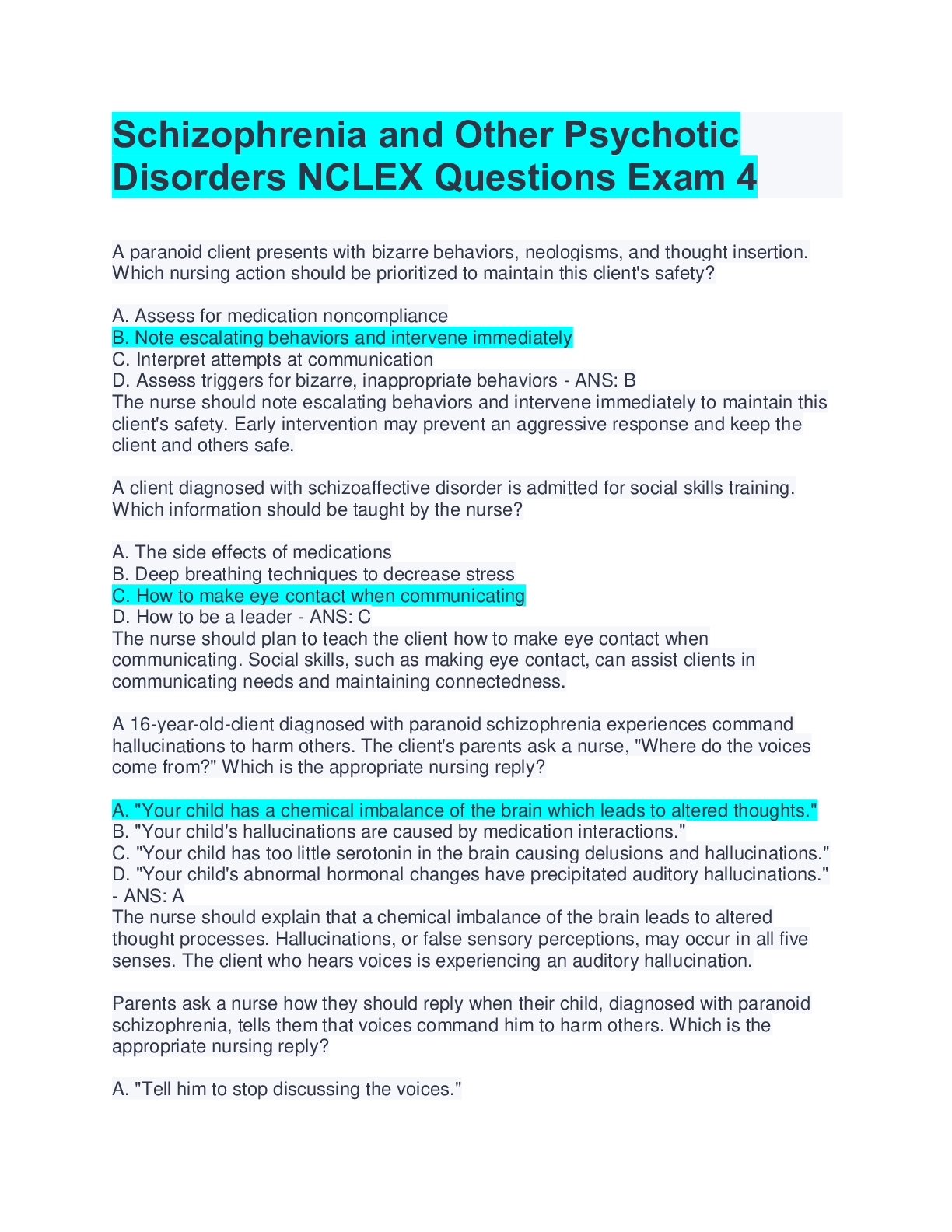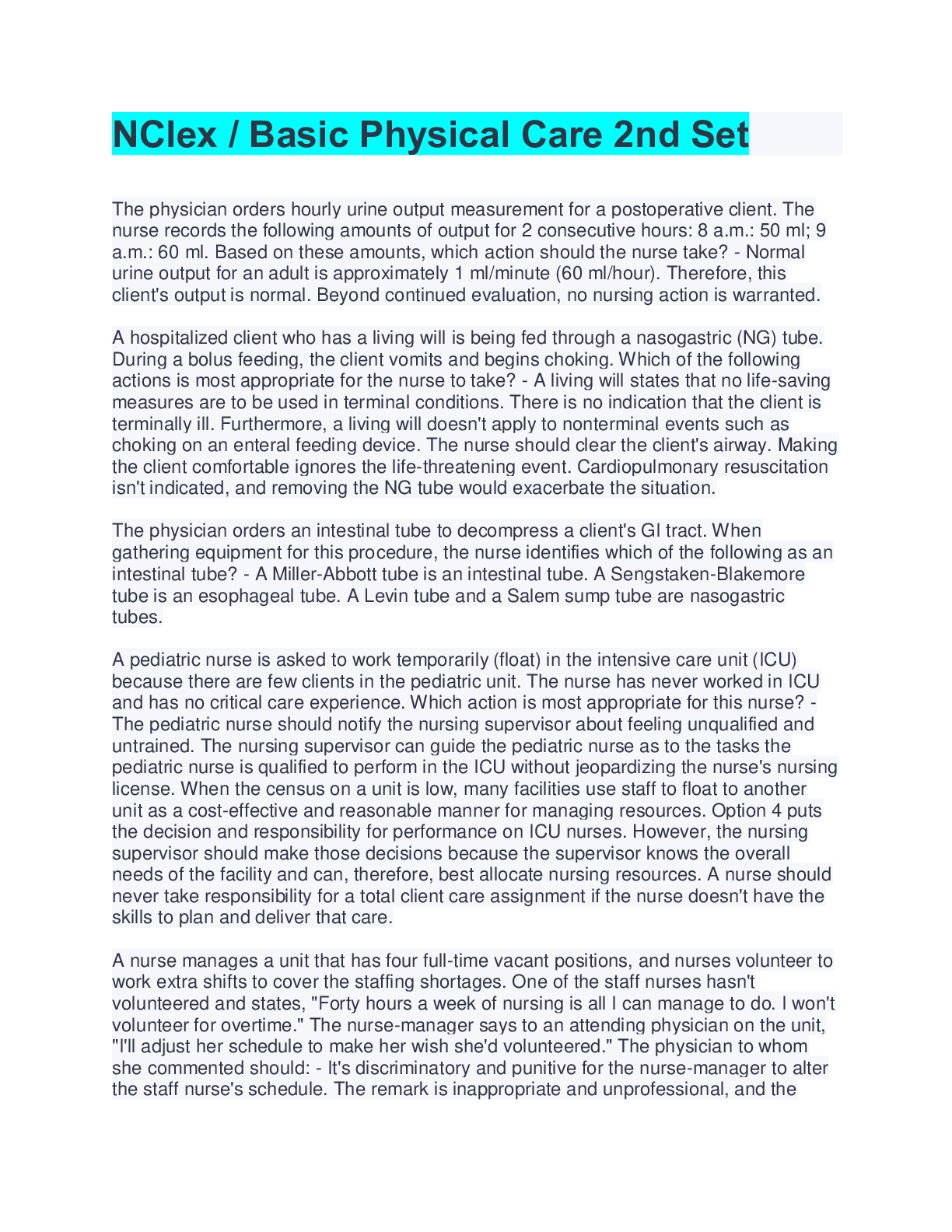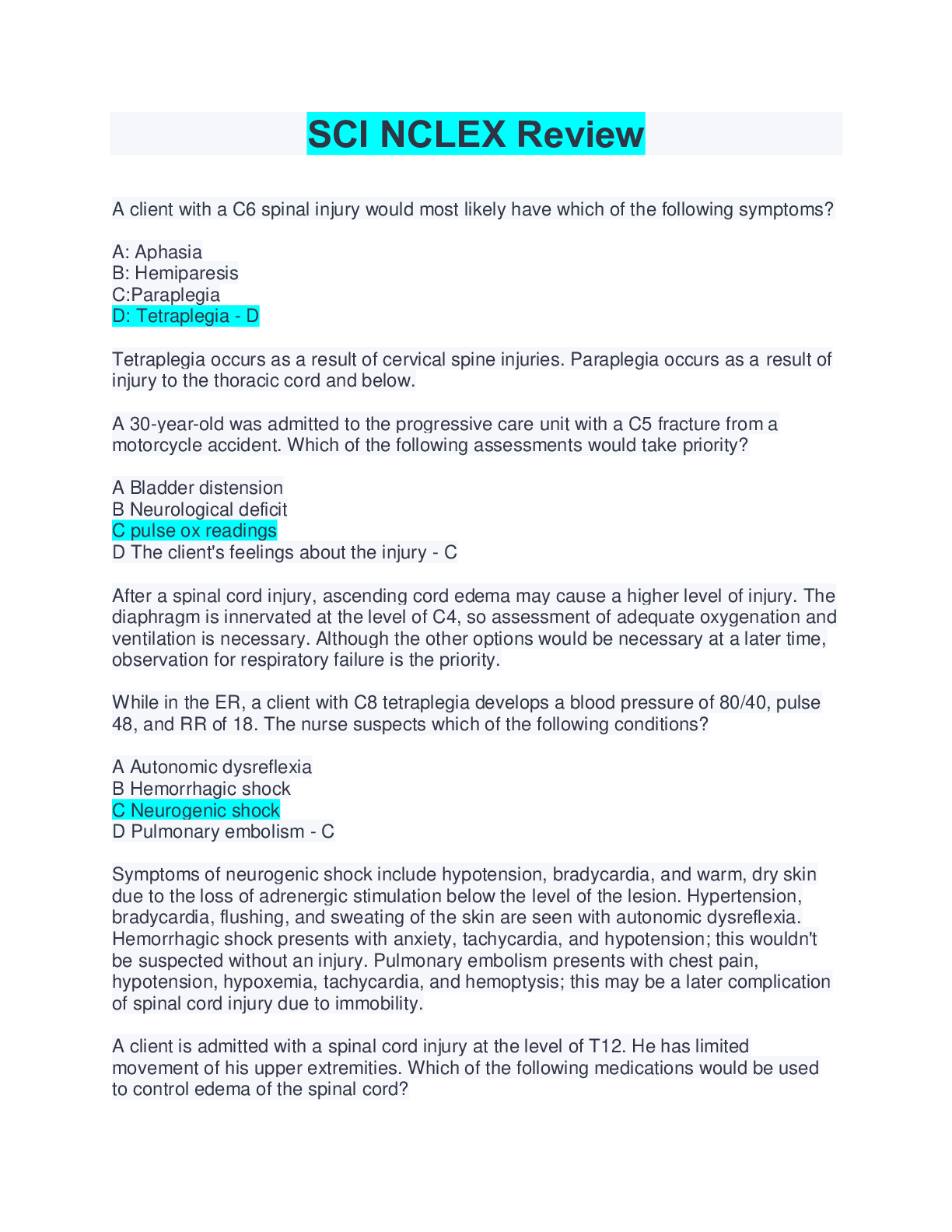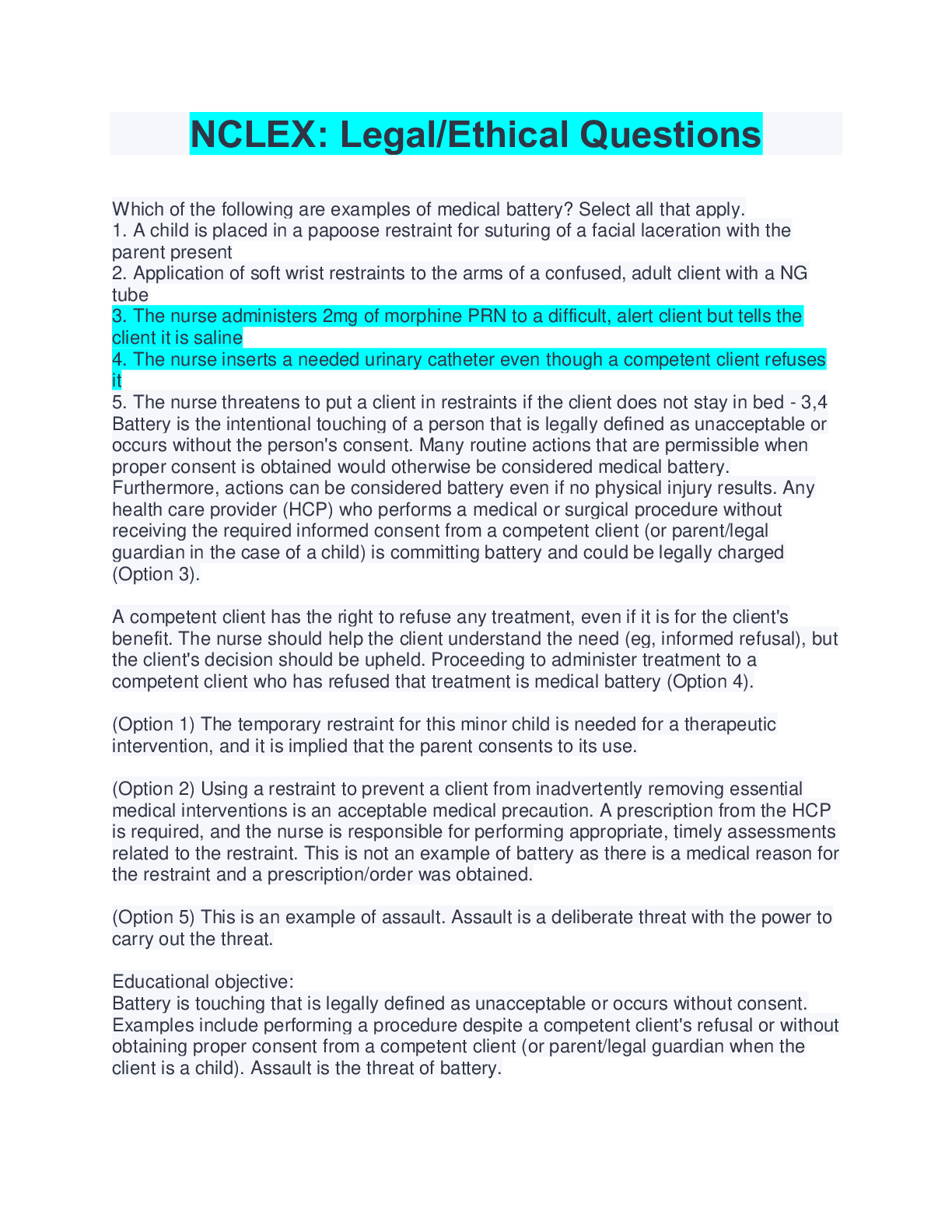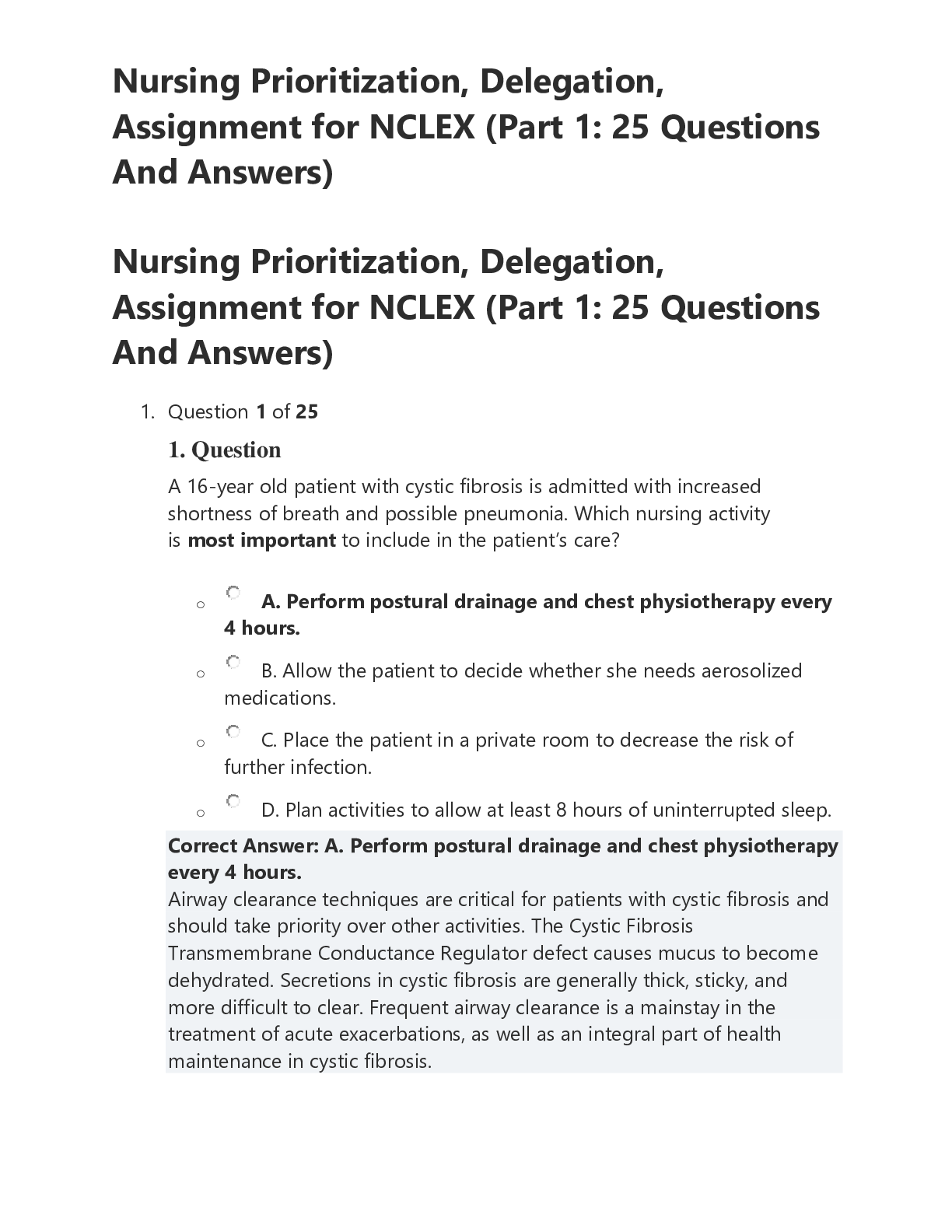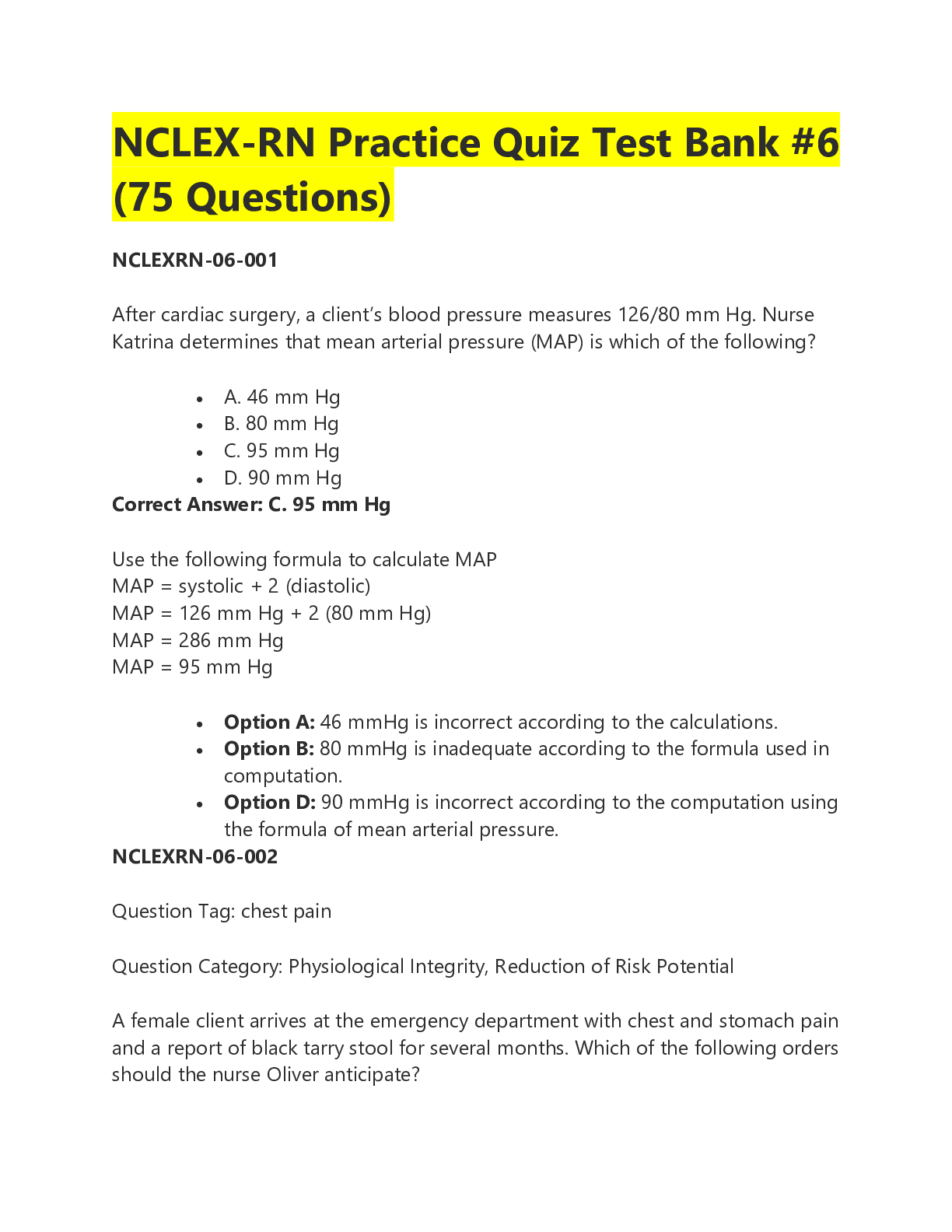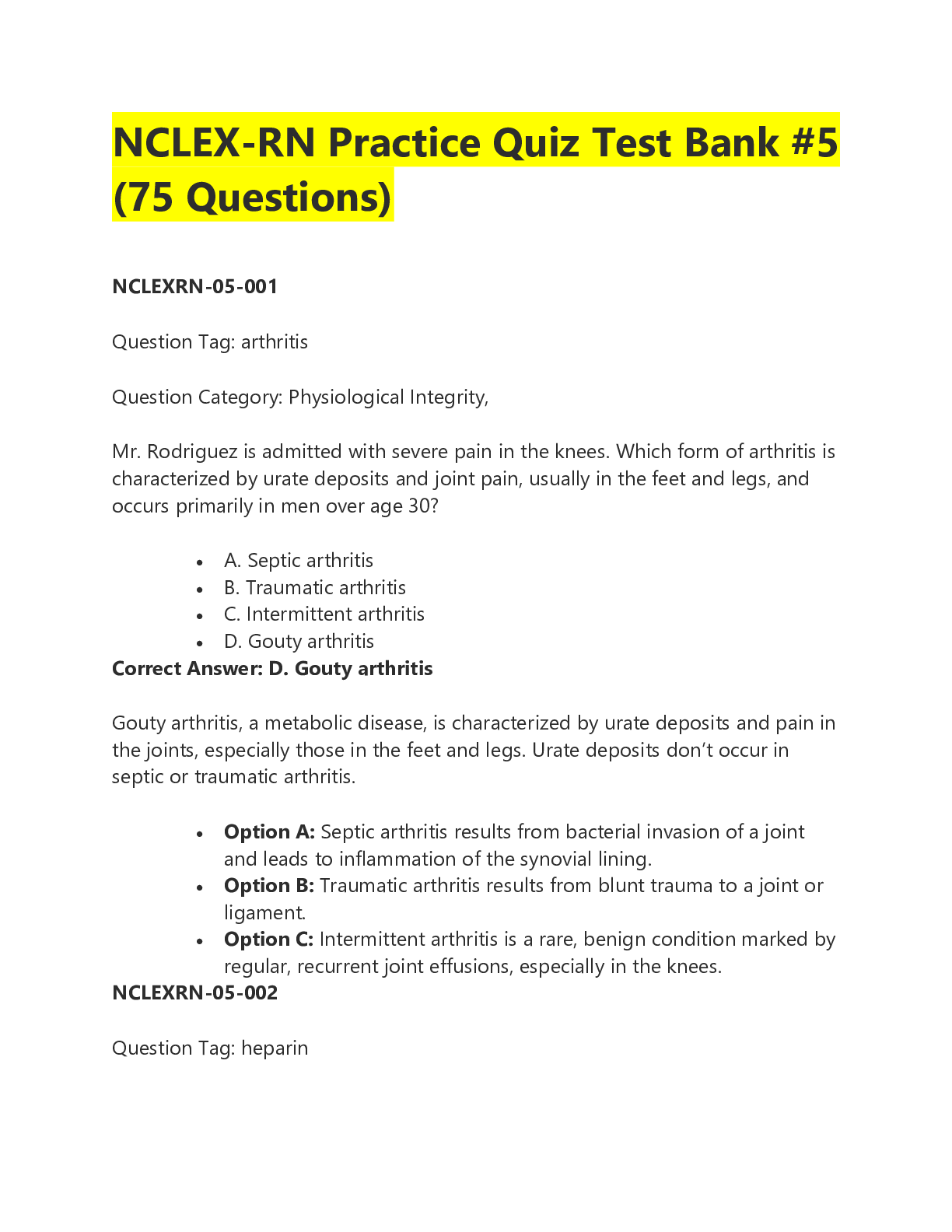*NURSING > NCLEX > Touhy & Jett: Ebersole and Hess’ Gerontological Nursing & Healthy Aging, 5th Edition/Chapter 11: H (All)
Touhy & Jett: Ebersole and Hess’ Gerontological Nursing & Healthy Aging, 5th Edition/Chapter 11: Hydration and Oral Care
Document Content and Description Below
Chapter 11: Hydration and Oral Care Touhy & Jett: Ebersole and Hess’ Gerontological Nursing & Healthy Aging, 5th Edition MULTIPLE CHOICE 1. Which of the following is a true statement about... dental health in older adults? 2. An older adult with a gastrostomy tube has difficulty using the dominant hand. Which of the following should the nurse provide to prevent complications of the gastrostomy tube? 3. Which of the following is a true statement? 4. Which increases the risk for chronic dehydration in older adults? 5. Which of the following is a tNruUe RstSatIemNeGntTaBbo.uCt fOluMid intake for older adults? 6. The nurse notices that an older adult’s urine is greenish-brown. Which step should the nurse implement next? 7. An older woman asks a nurse, “You always seem to be telling me that I need to drink more water. How much water do I really need to drink?” The nurse bases her response on the knowledge that: 8. A nurse administers hypodermoclysis (HDC) to an older nursing home resident. The purpose of hypodermoclysis is 9. Which of the following statements describing oral care for the older population is correct? Regular dental care is essential and can prevent tooth loss. Losing one’s teeth is not a normal part of aging about 25% of adults older than 65 years of age are edentulous. Oral cancers occur more often in older individuals. The median age at diagnosis is 61 years. Oral examinations can assist in early identification and treatment. Medicare does not provide any coverage for oral care services. PTS: 1 DIF: Remember REF: p. 150 TOP: Teaching and Learning MSC: Health Promotion and Maintenance 10. In a long-term care facility, a nurse is having a discussion with the nurse aides about ways to deal with dementia clients who are uncooperative with mouth care. Appropriate methods to use include a. speaking to the client sternly and instructing the client to open the mouth and cooperate immediately. b. having another nurse aide assist in holding the client’s mouth open with a tongue depressor. c. involving the client in the process of oral hygiene, such as using the hand-over-hand technique to brush the client’s teeth. d. quickly performing oral hygiene without explanation because the client is uncooperative. ANS: C With uncooperative individuals, it is important for the caregiver to be at eye level and explain all actions with step-by-step instructions. Speaking to the client sternly, having another nurse aide hold the patient’s mouth open, or performing oral hygiene without an explanation will only serve to agitate the patient. Involving the client and having the client participate to the extent possible is important. NUsinRg aIhanGd-oBve.r-ChanMd technique is effective. U S N T O PTS: 1 DIF: Analyze REF: p. 152 TOP: Teaching and Learning MSC: Health Promotion and Maintenance 11. A nurse is observing a nurse aide perform denture care for a resident in the nursing home. The nurse recommends that the nurse aide receive additional education on denture care when the nurse observes which of the following? a. The nurse aide places a face cloth in the sink and fills the sink half full with water. b. The nurse aide uses toothpaste to clean the dentures. c. The nurse aide uses a specially designed denture brush to clean the dentures. d. The nurse aide stores the dentures in a denture cup filled with denture cleansing solution. ANS: B Toothpaste is not used to clean dentures because it abrades denture surfaces. All of the other options are correct steps in the process to cleanse dentures. PTS: 1 DIF: Remember REF: p. 151 TOP: Teaching and Learning MSC: Health Promotion and Maintenance MULTIPLE RESPONSE 1. According to Healthy People 2020, older adults have been identified as a priority, addressing goals to improve dental health. Identify the correct dental health goals for older adults. (Select all that apply.) a. Reduce the proportion of adults with untreated dental decay. b. Prevent and control oral and craniofacial diseases, conditions, and injuries. c. Reduce the proportion of oral and pharyngeal cancers detected at the earliest stages. d. Improve access to preventive services and dental care. e. Reduce the proportion of older adults with untreated caries. f. Increase the proportion of older adults 65 to 74 years of age who have lost all of their natural teeth. ANS: A, B, D, E In a push toward wellness, older adults were identified as a priority area for the first time. Good oral hygiene and timely assessment of oral health are essentials of nursing care. PTS: 1 DIF: Remember REF: p. 149 TOP: Nursing Process: Planning MSC: Health Promotion and Maintenance 2. Which of the following are age-related changes that affect hydration status? (Select all that apply.) a. Decrease in thirst sensation b. Decrease in total body water c. Decrease in ability of kidneys to maximally concentrate urine d. Decrease in bone marrow mass e. Decrease in bladder capacity ANS: A, B, C NURSINGTB.COM As one ages, thirst sensation decreases and is not proportional to metabolic needs in response to dehydrating conditions. There is a decrease in total body water. The kidneys are less able to maximally concentrate urine, resulting in a loss of water. Although there is a decrease in bone marrow mass, this does not impact hydration status. As one ages, bladder capacity decreases; however, this does not directly impact hydration status. PTS: 1 DIF: Remember REF: p. 146 TOP: Teaching and Learning MSC: Health Promotion and Maintenance 3. A nurse is performing an admission assessment on an older patient who presented with a high fever and cough, reduced oral intake for 3 days, and lower extremity weakness. The patient has sunken eyes, and the patient’s skin turgor over the sternum is poor. The nurse suspects that the patient is dehydrated. Which of the following are indicators of dehydration in this patient? (Select all that apply.) a. Poor skin turgor over the sternum b. Lower extremity weakness c. High fever d. Sunken eyes e. Cough ANS: B, D Older adults often present atypically when dehydrated. Skin turgor over the sternum is not a reliable marker in older adults because of the loss of subcutaneous tissue with aging. Lower extremity weakness and sunken eyes may indicate dehydration. A high fever and cough can be associated with many other conditions and are not typically signs of dehydration. PTS: 1 DIF: Apply REF: p. 146 TOP: Teaching and Learning MSC: Health Promotion and Maintenance 4. Which of the following nursing interventions should be implemented to prevent dehydration in hospitalized older adults? (Select all that apply.) a. Implementing intake and output recording for any patients with fever, diarrhea, vomiting, or an infection b. Limiting duration of nothing by mouth (NPO) requirements for diagnostic tests and procedures c. Administering intravenous (IV) fluids to all hospitalized older adults d. Limiting the use of diuretic medications in hospitalized older adults e. Making sure that hospitalized patients have easy access to fluids ANS: A, B, E To prevent dehydration, it is essential to closely monitor hospitalized older adults. Any individual who develops fever, diarrhea, vomiting, or an infection should be monitoring closely by implementing intake and output records and providing additional fluids. NPO requirements for diagnostic tests and procedures should be as short as possible. It is not appropriate to administer IV fluids to all hospitalized older adults. IV fluids are administered when there is a clinical indication. It is not appropriate to limit the use of diuretics. Diuretics are an important treatment for many older patients. Hydration management involves acute and ongoing management of oralNintaRke.IOraGl hyBd.raCtionMis the first line of treatment for dehydration prevention. U S N T O PTS: 1 DIF: Apply REF: p. 147 TOP: Teaching and Learning MSC: Health Promotion and Maintenance 5. An older adult complains of xerostomia. Which of the following interventions should the nurse implement for this patient? (Select all that apply.) a. Encourage the patient to brush and floss teeth regularly. b. Encourage the patient to have regular dental screenings. c. Provide antiseptic mouth wash (such as Listerine) for the patient. d. Encourage adequate intake of water. e. Provide saliva substitutes. ANS: A, B, D, E Individuals with xerostomia should have regular dental screenings and be encouraged to practice good oral hygiene. Adequate intake of water is important, as if avoidance of alcohol and caffeine. Saliva substitutes may be helpful. Antiseptic mouth washes usually contain alcohol, which can further dry the mouth. PTS: 1 DIF: Apply REF: p. 149 TOP: Teaching and Learning MSC: Health Promotion and Maintenance 6. A nurse is caring for an older adult who has a gastrostomy tube. The nurse is developing a care plan related to oral care. Which of the following should the nurse consider for this patient? (Select all that apply.) a. Oral care should be provided every 4 hours. b. Teeth should be brushed with a toothbrush after each tube feeding. c. Lemon glycerin swabs should be used in between feedings to keep the mouth moist. d. Foam swabs should be used in place of a toothbrush to clean the teeth after each tube feeding. e. Oral care should be provided only twice daily if the older adult is edentulous. ANS: A, B Tube feeding is associated with significant pathological contamination of the mouth, greater than in individuals who receive oral feeding. Oral care should be provided every 4 hours for patients with gastrostomy tubes and teeth should be brushed with a toothbrush after each feeding to decrease the risk of aspiration pneumonia. Lemon glycerin swabs should never be used for oral care because they dry and inhibit saliva production. Foam swabs do not remove plaque as well as tooth brushes. Oral care is required even if the individual is edentulous. PTS: 1 DIF: Apply REF: p. 152 TOP: Teaching and Learning MSC: Health Promotion and Maintenance NURSINGTB.COM [Show More]
Last updated: 1 year ago
Preview 1 out of 7 pages
Instant download

Buy this document to get the full access instantly
Instant Download Access after purchase
Add to cartInstant download
Reviews( 0 )
Document information
Connected school, study & course
About the document
Uploaded On
Aug 08, 2021
Number of pages
7
Written in
Additional information
This document has been written for:
Uploaded
Aug 08, 2021
Downloads
0
Views
60


